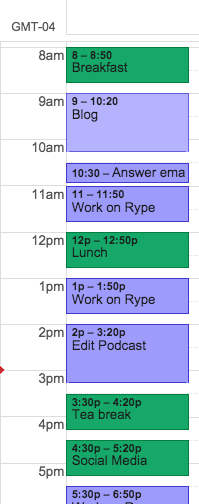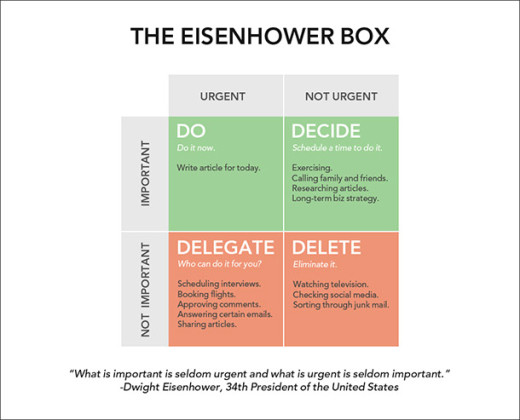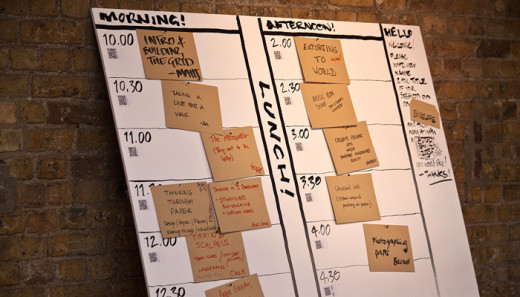
Time is the most valuable commodity we have.
Unlike money, every minute that goes by is another we can never get back.
We have to maximize the time we have each day to focus on what will improve the quality of our lives, like learning a new skill.
Whether it’s improving your writing skills, learning a new language, or picking up a new instrument, learning something new is proven to improve our career opportunities, enhance brain health, and accelerate learning speed.
While the benefits of learning a new skill are clear, the main problem we have is finding the time in our schedule to learn something new in the first place.
Here’s how you can find more time in your schedule to learn something new
Track Your Schedule
Before we dig deeper in finding more time in our schedules, we have to know how we spend our day in the first place to learn something new.
Start by tracking everything you’re doing during the day on your calendar. Keep it simple by categorizing each task into two colors representing:
- Work time (blue)
- Free time (green)

Looking at my personal schedule, it looks like I have some extra time from: 3:30–5:30pm, before breakfast (by getting up earlier), lunch time, and after 7pm.
This is already more than enough free time to spend 30–60 minutes a day to learn something new, instead of checking social media or during lunch time.
When you keep track of exactly what you’re doing each day, you’ll be surprised to know how much free time you have to invest to learn something new.
Prioritization
To prioritize your schedule, we’re going to use a framework developed by the 34th President of the United States, who led one of the most productive lives ever: Dwight Eisenhower.
Eisenhower’s most famous productivity strategy is known as “The Eisenhower Box.” This powerful organizational framework allows you to prioritize the numerous tasks you have in the day into four categories:
- Urgent and important (tasks you will do immediately).
- Important, but not urgent (tasks you will schedule to do later).
- Urgent, but not important (tasks you will delegate to someone else).
- Neither urgent nor important (tasks that you will eliminate).

What’s powerful about this framework is that there’s a simple action task with each categorization.
“What is important is seldom urgent and what is urgent is seldom important.” -Dwight Eisenhower
The first thing you should focus on is what you can immediately delgate or eliminate from your action task. Whether you have a to-do list or a calendar schedule, ask yourself:
- What’s my ultimate goal that I am trying to achieve? (learn Spanish, increase your business revenue, etc.)
- Which of these tasks will bring me closer to my goal?
- Which of these non-impactful tasks can I outsource or eliminate completely?
Too often we give prioritization to unimpactful tasks and waste a big chunk of our day, instead of delegating it or eliminating it.
As the Pareto’s Law states, only 20% of our efforts will result in 80% of our desired results, so makes sure you choose your “do” and “decide” sections of the Eisenhower Box strategically and thoughtfully.
After filling in your Eisenhower Box, re-examine your schedule again and delete all the tasks in your schedule that belongs to the “delegate” or “delete” sections.
“Being busy is a form of laziness — lazy thinking and indiscriminate action.” — Tim Ferriss
Optimization
The next step is to optimize your schedule.
You can do this in either three ways:
- Shorten your work tasks
- Cut out your least important free time
- Bundle your free times together

- Shortening your work tasks — most of us are talented at procrastinating. Best explained by the popular Parkinson’s Law, the amount of time that one has to perform a task is the amount of time it will take to complete it. This means that if you think a work task will take 2 hours, give yourself a deadline of 1 hour. It’s likely you’ll find a way to focus in order to get it done in time.
- Cut out unimportant free times — are there spare times in your day, where you simply do nothing or time-wasting tasks? Perhaps you find yourself going on social media in the late afternoon everyday, or checking email more than 5 times per day. We all have them.
Cut out one of these unnecessary free times and replace it with your skill acquisition time. - Bundle your free times together — this is a quick hack that can give you the best of both worlds. While I don’t recommend multi-tasking when you’re doing important work, it can be effective in saving you time when you’re slacking. For example, rather than giving up social media or email time, you can perform these tasks together. While bundling these together may not allow you to focus 100%, it won’t affect your output since you’re multi-tasking during your free time, not your work time.
Once you have completed all three or even one of these optimization processes, you’ll discover anywhere from one to several hours of extra time that you can dedicate to learn something new.
Over To You
Which of these processes did you find the most useful in finding more time?
What skill will you learn once you find more time in your schedule?
Read Next: The complete guide to never quitting anything again
Image credit: Shutterstock
Get the TNW newsletter
Get the most important tech news in your inbox each week.





